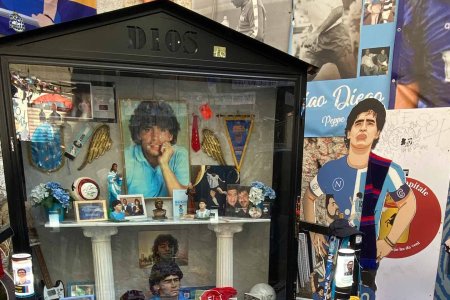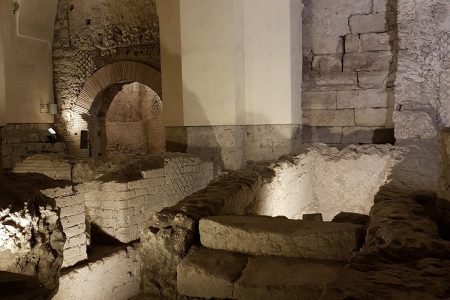Table of Contents
When one speaks of Naples, one cannot fail to mention Maradona and vice versa. They have become an inseparable union, even today that the Pibe de Oro is no more. Diego Armando Maradona for many is the greatest soccer player of all time, and in his 7 years with Napoli Calcio he became a true legend for the Parthenopeans.
From his unveiling on July 5, 1984 to his farewell at the San Paolo in 1991, Maradona and Napoli's has been a long love story filled with success. In fact, during this golden period, Napoli was able to put 2 Scudetti, an Italian Cup, an Italian Super Cup and a Uefa Cup in its trophy cabinet.
Maradona's, however, has been a life of. light and shadow, because of his drug addiction problems and the media exploitation of many people who revolved around him. His own medical death is being investigated and has his doctors under investigation.
Maradona: a short and troubled life
The fifth of eight children, Diego Armando Maradona was born in Lanus in 1960 and as a child immediately showed the traits of a great champion, thanks to an over-the-top soccer technique. His career began in 1976 with Argentinos Juniors, and he then served in the Boca Juniors between 1981 and 1982. In the summer of 1982 Maradona arrived at Barcelona, to remain there until 1984.
In this year he was acquired after lengthy negotiations by Napoli Calcio, giving birth to the legend of Maradona in Naples. The Naples adventure lasted a full 7 years, marked by great successes and national and international trophies, including winning the 1986 World Cup. However, everything came to an abrupt end in March 1991, when the player was found positive at a control anti-doping.
You might be interested
Naples Champion of Italy: Scudetto Tour in the Historic Center.
per person Book
Tour of Naples by minibus in the historic center
per person Book
Visit Naples in half a day: guided tour from Piazza Dante to Piazza del Gesù
per person Book
The Catacombs of San Gennaro in Naples
per person
Admission ticket to the Neapolis Sotterrata and the Basilica of San Lorenzo Maggiore
per person Book
After a year and a half of disqualification, Maradona moved on to Sevilla, then returned to Argentina to play with Newell's Old Boys and Boca Juniors, finally retiring in 1997. A controversial personality due to his political views and problems with drugs, from which he detoxed several times, Maradona also attempted a coaching career and led the Argentine national team from 2008 to 2010 with poor results. He then coached in Saudi Arabia, Mexico, and the Argentine league between 2011 and 2019.
As for his personal life, Maradona had two daughters by his ex-wife Claudia and 3 other illegitimate children, including Diego Jr., had by the Neapolitan Cristiana Sinagra and recognized only in 2007. However, his health over the years has been precarious, with several hospitalizations and difficult times. In early November 2020 he was hospitalized for brain surgery. Discharged, he spent his inpatient days at home, only to die suddenly on November 25 from pulmonary edema.
His death was a blow to both Argentines and Neapolitans, orphans of their legend. His funeral in Buenos Aires was attended by thousands of citizens and many of his former teammates. As of April 2023, eight people have been remanded for trial for the champion's death.
After his death, Maradona's legend continues to shine everywhere in the world, but especially in his homeland. In fact, in the days following his passing, Buenos Aires' Sportivo Pereyra club in the Barracas neighborhood decorated the roof of the field with a soccer version of the Creation of Adam Of the Sistine Chapel. The mural shows Maradona as God touching Messi's hand, a new Adam reaping his legacy.
Maradona in Neapolitan culture
Today as in the 1980s, the Pibe de Oro is still a true idol for Neapolitans who see in him a symbol of napoletanità around the world. Maradona is perceived in Naples as a sports and democratic hero, as his humble origins have always brought him closer to ordinary people.
His accumulated wealth never made him lose this spirit of simplicity and closeness with the weakest and most disadvantaged in society. To this must be added his battle against the strong powers, especially in Naples where he stood as a representative of the oppressed of the south against the overwhelming power of the northern teams.
Wandering around the alleys of Naples, one can encounter many monuments named after Maradona. How not to mention the famous altar Inside Bar Nilo in Piazzetta Nilo. It was created as a joke and takes its cue from traditional votive shrines. In addition to the player's photo, the curiosity is that the shrine would hold the footballer's hair!
The Argentine champion had then received honorary citizenship from the City of Naples in 2017, and on the first anniversary of his death in 2021, two sculptures depicting him are being dedicated.
One was made by the sculptor Dominic Sepe and was inaugurated on November 25 outside the stadium, while the second was commissioned by former manager Stefano Ceci and was later donated to Napoli. Meanwhile, on December 4, 2020, the City Council changed the name of the stadium from San Paolo to Diego Armando Maradona.
Since the legendary player's passing in Naples, a continuous pilgrimage of tourists and fans has begun to the Quartieri Spagnoli, where one of two murals depicting Maradona can be seen. The first is located on Via Emanuele De Deo, near what has been renamed the Maradona Square.
It was painted on a 6-story building in 1990, on the occasion of winning the second Scudetto. Created by young artist Mario Filardi, it was restored in 2016. The other large mural is the one on Via Taverna del Ferro in San Giovanni a Teduccio, which artist Jorit Agoch created in 2017 on the walls of public housing. The work was co-financed by then-captain Hamsik and various associations.
From these small examples it can be understood how Maradona for Naples represents a kind of lay saint, a'immortal icon that will forever make the relationship between the city and the soccer team strong. Even in the years away from the Neapolitan capital, Diego never forgot the Neapolitan period, continuing to cheer thousands of miles away. Maradona's is thus a true cult that makes the Neapolitans' cultural heritage even more precious and incomparable.






0 Comments